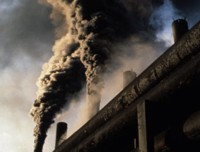Keeping the Great White North White
 Should permafrost thawing accelerate as expected, resulting carbon dioxide and methane emissions will significantly amplify global warming, according to a report published by the United Nations Environment Programme (UNEP) titled Policy Implications of Warming Permafrost.
Should permafrost thawing accelerate as expected, resulting carbon dioxide and methane emissions will significantly amplify global warming, according to a report published by the United Nations Environment Programme (UNEP) titled Policy Implications of Warming Permafrost. Permafrost is ground that stays frozen for at least two years in a row and occurs in about a quarter of the land surface in the Northern Hemisphere; it contains twice the amount of carbon as the atmosphere (1,700 billion tonnes of carbon stored as frozen organic matter).
UNEP’s permafrost report recommends that the Intergovernmental Panel on Climate Change assess permafrost emissions and establish a national monitoring network and adaptation plans to address the potential impacts of this significant source of greenhouse gas emissions.
A global temperature increase of 3°C means a 6°C increase in the Arctic, resulting in an irreversible loss of anywhere between 30 to 85 per cent of near-surface permafrost.
“Reducing black carbon soot and other short-lived climate pollutants can cut the rate of Arctic warming by two-thirds. We need a crash course that starts today with black carbon, which is responsible for half of the Arctic warming, or about 1.0 C” said Durwood Zaelke, President of the Institute for Governance and Sustainable Development.
Other short-lived climate pollutants include methane, which is being released from the thawing permafrost, tropospheric ozone, and hydrofluorocarbons or HFCs.
Black carbon is targeted by the new Climate and Clean Air Coalition to Reduce Short-Lived Climate Pollutants, along with the other short-lived climate pollutants. There are currently 27 members of the Coalition including the G8 countries, the European Commission, World Bank, UNEP, the United Nations Development Programme, and several NGOs. UNEP hosts the Secretariat.
A recent Canadian study demonstrated that black carbon emissions from light-duty gasoline vehicles were a factor of two higher than previous North American measurements, and a factor of nine higher than the previous black carbon emission factor models.
“The Climate and Clean Air Coalition is moving fast to reduce climate impacts from the short-lived climate pollutants, as a critical complement to the primary battle to reduce emissions of CO2,” said Zaelke. “But we need both speed and scale to achieve the full potential of the Coalition.”
It is estimated that short lived emissions, such as methane, black carbon (soot), and tropospheric ozone, which constitute about half of the climate warming from current anthropogenic emissions, have critical impacts on water cycle, crop yields, air quality and human health.
This issue is of particular importance for Arctic countries, as black carbon has an additional warming effect when deposited on snow and ice.
You can return to the main Market News page, or press the Back button on your browser.

